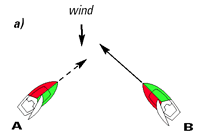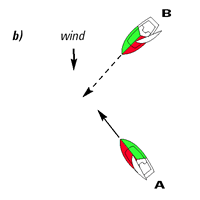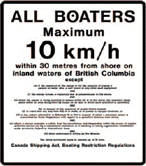Recreational boaters should be prepared to share
waterways with wildlife, swimmers, divers, other
boaters and watercraft ranging from sailboats to float
planes. As an operator, you must respect others on
or near the water for them to respect your rights.
Operators using courtesy and common sense will
not create a hazard, threat, stress or be an irritant to
others, to the environment or to wildlife.
Rules of the road ^
| Following the rules of the road is an important part
of recreational boating. Everyone is entitled to a safe,
fun time on the water so learn the rules and boat by
them. |
|
Doing so is not just a matter of courtesy; it is
the law, set out in the Collision Regulations. They
apply to every vessel and operator on all navigable
waters — from canoes to supertankers.
Right-of-way rules
^
a) When each sailing vessel has the wind on a
different side, the vessel that has the wind on
its port (left) side must keep out of the way of
the other. In the illustration below, A keeps
clear of B.
If a sailing vessel has the wind on its port side
and the sailor cannot determine with certainty
whether the other vessel has the wind on its
port or starboard side, the first vessel must
keep out of the way of the other. |

|
| b) When both sailing vessels have the wind on the same side, the vessel to windward* shall keep out of the way of the vessel to leeward. B keeps clear of A.
* The windward side is defined as the side opposite to
that on which the mainsail is carried or, in the case of a square-rigged vessel,
the side opposite to that on which the largest fore-and-aft sail is carried.
|

|
Maintaining a proper lookout and
avoiding a collision
^
Maintaining a constant lookout is common sense
and the law. If you are sharing the water with large
vessels remember they have limited visibility,
manoeuvrability and take much longer to come to
a stop. Be prepared to move out of the way of these
vessels for these reasons.
Be aware and be considerate ^
| Never buzz, try to spray swimmers, cut in front of
or try to jump the wake of other vessels. Some of
the worst boating accidents happen when speed or
distance is misjudged. It only adds to the tragedy
when the two parties involved are friends or relatives. |
|
Vessels less than 20 m (65’7”) in length, including
sailing vessels, must stay out of the way of larger
vessels that can safely navigate only within the
channel. A large vessel will remind you of the
requirement to give way by giving five or more
short blasts of its horn. This means the situation
has escalated to an emergency and you must take all
necessary steps to get out of the way.
Reduce engine noise ^
| It is not only a matter of consideration; pleasure craft
fitted with a motor must incorporate a means that
will contribute to the reduction of the motor’s noise
level. This means must be in use at all times when
operating within five nautical miles (9.26 km) of
shore. Stock (unmodified) outboard engines are not
affected by this provision. |
|
Vessels built before January 1, 1960, or those engaged
in an official competition, formal training or final
preparation for an official competition are exempt.
Keep your distance from divers
below the surface ^
| Diving is a popular water activity so keep an eye
out for diving flags at all times. Keeping a vigilant
lookout is especially important because vessel wake,
weather and other factors make it even more difficult
to spot surface bubbles from those underwater.
Know what these diver down flags look like. |
|
Vessels engaged in diving operations must display
the international blue and white Code Flag Alpha. A
red and white flag that may also be carried on a buoy
marks the area where diving is in progress, although
divers may stray from the boundaries of the marked areas.
When you see either flag, keep clear of the vessel and
diving site and move ahead slowly and with caution.
Steer clear of shipping lanes ^
Some operators do not realize the gamble they take
when they cut across shipping lanes or in front
of larger vessels. These vessels probably will not
see you until it is too late, so apply these codes of
conduct when boating.
- Always, but especially at crossing zones,
maintain a vigilant lookout and be prepared to
yield to large vessels. Use all available means
adapted to the circumstance and conditions,
including radar and radio (if so equipped).
- Small craft should navigate in groups so they
are more visible.
- In fog or high winds, small craft operators
should avoid taking to the water.
- Above all, keep clear of docked ferries, ferries
in transit, or vessel in tow.
Operate at a safe speed ^
You may have to stop or turn suddenly to avoid a
collision, so operate at a safe speed. When choosing
a safe speed consider:
- The visibility conditions (fog, mist, rain and
darkness) and your ability to see ahead
- The wind, water conditions and currents
- The manoeuvrability of your boat
- The traffic density, types of vessels in the area
and their proximity
- The proximity of any navigational hazards
(rocks, and tree stumps)
Be especially careful when operating in areas of
restricted visibility, such as entering or exiting a
fog bank.
Consider the effects your boat’s wake might create
while choosing your speed. Your boat’s wake can
damage other vessels, docks and the shoreline. |
|
Also, consider other users of the waterway such as
swimmers, divers and people aboard small vessels
that your wake could cause to capsize. You could be
held liable for these damages.
Waterskiing and other towing
activities ^
The rules governing waterskiing include other
towing activities such as barefoot skiing, tubing,
kneeboarding and parasailing. The Small Vessel
Regulations require a spotter to be onboard, as well
as the following: |
|
- There must be a seat available for each person
being towed in case recovery is necessary.
- Only personal watercraft designed to carry
three or more people can be used for towing
waterskiers.
- Towing activities are not allowed in the period
from one hour after sunset to sunrise.
- The towing vessel cannot be remotely
controlled.
Respect and protect the aquatic
environment ^
Canada’s lakes, rivers and coastal waters are ours
to share so follow good environmental boating
practices. It is irresponsible, and an offence, to
pollute the water with things like oil and garbage.
If you have accidentally polluted the water,
or see evidence of someone doing so, report it
immediately to a Government of Canada pollution
prevention officer or call one of the following
telephone numbers:
Newfoundland and Labrador
1-800-563-9089
Prince Edward Island, Nova Scotia and New Brunswick
1-800-565-1633
Quebec
1-800-363-4735
Ontario, Manitoba, Saskatchewan, Alberta, Northwest
Territories and Nunavut
1-800-265-0237
British Columbia and Yukon
1-800-889-8852
In some areas of Canada, vessels are prohibited
from pumping sewage (also known as blackwater)
overboard.
Areas in which pleasure craft are required to have
holding tanks and cannot pump sewage overboard:
- Ontario: all waters
- Manitoba: the Assiniboine River in Winnipeg,
the Red River and Shoal Lake
- British Columbia: there are several restricted
areas – refer to the Schedule in the Pleasure
Craft Sewage Pollution Prevention Regulations
Wherever you operate, it is a courtesy to others
who use the same waterways to dispose of your
blackwater at a pump-out facility. When planning
your trip, check with local authorities for places
where pump-out facilities are available.
Green boating tips
- Keep your bilge clean and do not pump oily
water overboard.
- Use bilge sorbents in place of detergents.
- Do not pump your sewage over the side. Use
a holding tank.
- Observe provincial and federal sewage
regulations.
- Bring your garbage home. Do not litter.
- Use detergents sparingly. Even
biodegradable cleaners are hard on the
aquatic environment.
- When fuelling, do not top off tanks. Clean
up spilled fuel.
- Use only paints approved for marine use.
- Avoid shoreline erosion. Watch your wake
and propeller wash.
- Report pollution when you see it.
Boating Restrictions ^
If you are part of a local group, association or
municipality and you feel a restriction may be
needed in your area, contact a Transport Canada
Centre. Before your request can be considered for
addition to the Boating Restriction Regulations, the
need for establishing such a restriction should be
assessed and public consultation will be held at the
local level. Once a boating restriction is in place it is
enforceable* by:
- Police officers
- Conservation officers
- Persons appointed by the Minister of Transport
* Sanctions are in the form of tickets or summons.
Reading a restriction sign ^
There are five shapes associated with boating
restriction signs. The colour of the frame is
international orange. Signs with a section with a
green border tell you a special condition applies to
the restriction. The symbol on the sign indicates
the type of restriction that applies. If the sign is
arrow-shaped, the restriction applies in the direction
pointed by the arrow. Know what these signs mean.
 |
 |
 |
| No power vessels |
No internal combustion
or steam engine permitted
|
Power limit |
|

|
 |

|
| No skiing |
Standardized speed limit (normally 5, 10, 25,
40, 55) |
No regatta |
|

|
 |

|
| No Boats |
No power driven vessels or
vessels driven by electrical propulsion
in the direction indicated by the arrow |
Combined sign (no skiing and speed limit) |
|

|
 |
|
| No skiing north of the sign |
No power driven vessels
or vessels driven by electrical
propulsion during the hours and
on days in red |
|
Province-wide shore-line speed
restrictions ^
Provinces from Ontario, westward to and including
British Columbia (inland waters only in British
Columbia) have adopted province-wide restrictions
limiting speed to 10 km/h within 30 m (98’ 5”)
from shore on all waters within their boundaries,
except for:
|

|
|
- Waterskiing, where the boat follows a trajectory
perpendicular to the shore
- In rivers less than 100 m (328’ 1”) in width, or
canals or buoyed channels
- In waters where another speed is prescribed
under a schedule to the regulations
This limit is not posted.
Safety in historic canals and
locks ^
| When visiting one of Canada’s historic canals make
sure your boat has good mooring lines and securely fastened
floating fenders in sufficient numbers and
size. |
|
There are a number of activities prohibited while in a
canal, some being:
- No excessive noise between 11 p.m. and 6 a.m.
- No fishing within 10 m (32’10”) of a lock or
approach wharf or fishing from a bridge that
passes over a navigation channel.
- No diving, jumping, scuba-diving or swimming
in a navigation channel or within 40 m (131’)
of a lock gate or a dam.
- No waterskiing or other towing activities while
in a navigation channel or within 100 m
(328’ 1”) of a lock structure.
- No mooring a vessel to a navigation aid.
Visit Parks Canada at www.pc.gc.ca for information
on historic canals.
Passage through a lock ^
Obey the posted speed limits and mind your boat’s
wake, especially when approaching a lock (wake
limits have precedence over speed limits). Other
things to remember: |
|
- Keep clear of the channel near lock gates so
vessels coming or going can do so safely.
- A blue line on the mooring wharf indicates
the waiting zone for vessels awaiting the
next lockage.
- Follow the instructions given by lockmasters
and bridge operators (at a number of lock
stations, a green traffic light is your signal
to proceed).
- Enter the lock slowly (the maximum speed
limit is 10 km/h) and have people at the bow
and stern of your boat with mooring lines ready
to use.
- If the lock is equipped with drop cables, loop
boat lines around them once safely positioned
in the lock. Do not tie your boat to the drop
cables. If the lock is equipped with floating
docks you may be told to tie-up to one inside
the lock chamber.
- Tend vessel lines carefully during the lockage;
looping a line around a deck cleat may provide
extra leverage.
- Never leave bow or stern lines unattended.
- Switch off the engine(s) and generator.
Open f lames and smoking are prohibited
during lockage.
- The bilge blower must be operating
during lockage.
When the lock gates open, wait for staff to direct
you to restart your engine. Make sure all lines are
returned to your boat and exit slowly and in order
if necessary. Watch out for wind, currents and
other vessels.
Procedures for using the St. Lawrence Seaway locks
differ from those outlined here. Consult the
St. Lawrence Seaway Authority’s Pleasure Craft
Guide, available from:
Head Office
202 Pitt Street
Cornwall, Ontario
K6J 3P7
613-932-5170
www.greatlakes-seaway.com
Safety around dams ^
Operators should be cautious near canal dams and
waste weirs where currents and undertows can be
very dangerous. It is illegal to jump, dive, scuba dive,
swim or bathe within 40 m (131’) of a dam.
PREVIOUS | TABLE OF CONTENTS | NEXT

